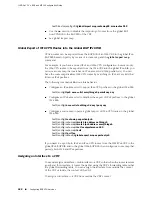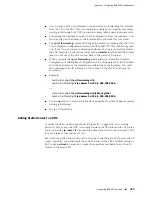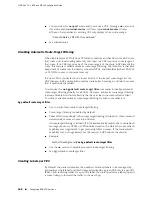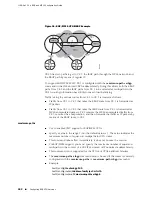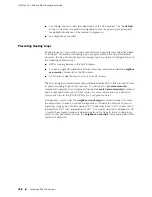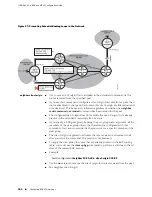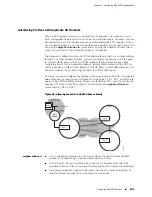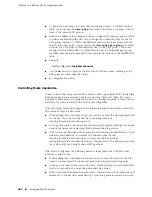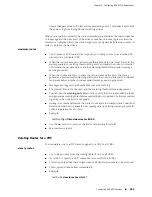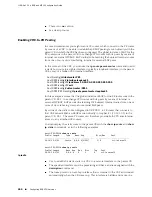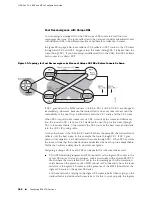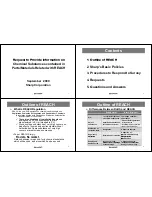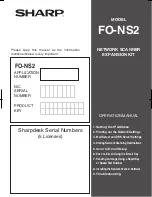
Disabling the Default Address Family
PE routers can exchange routes in the IPv4 address family, VPNv4 address family,
or both. Issuing the
neighbor remote-as
command automatically activates the IPv4
unicast address family, meaning that the PE router exchanges routes in the IPv4
unicast address family with that peer.
Example 1
The following commands illustrate how to configure the exchange of routes in both
the IPv4 unicast and the VPNv4 unicast address families for a BGP peer:
host1:vr1(config)#
router bgp 777
host1:vr1(config-router)#
neighbor 10.26.5.10 remote-as 100
host1:vr1(config-router)#
address-family vpnv4 unicast
host1:vr1(config-router-af)#
neighbor 10.26.5.10 activate
host1:vr1(config-router-af)#
exit-address-family
The
neighbor remote-as
command activated the IPv4 unicast address family for the
peer. The
address-family
command entered the context of the VPNv4 unicast family
and the
neighbor activate
command activated the address family for the peer.
Example 2
The following commands illustrate one way to disable the exchange of routes in the
IPv4 unicast address family and enable the exchange of routes in the VPNv4 unicast
address family:
host1:vr1(config)#
router bgp 777
host1:vr1(config-router)#
neighbor 10.26.5.10 remote-as 100
host1:vr1(config-router)#
address-family ipv4 unicast
host1:vr1(config-router-af)#
no neighbor 10.26.5.10 activate
host1:vr1(config-router-af)#
exit-address-family
host1:vr1(config-router)#
address-family vpnv4 unicast
host1:vr1(config-router-af)#
neighbor 10.26.5.10 activate
host1:vr1(config-router-af)#
exit-address-family
In this case, the
no neighbor activate
command specifically disables the IPv4 unicast
address family for that peer alone; no other peers are affected. The VPNv4 unicast
address family is activated for the peer as in Example 1.
Example 3
The following commands illustrate another way to disable the exchange of routes in
the IPv4 unicast address family and enable the exchange of routes in the VPNv4
unicast address family:
host1:vr1(config)#
router bgp 777
host1:vr1(config-router)#
no bgp default ipv4-unicast
host1:vr1(config-router)#
neighbor 10.26.5.10 remote-as 100
host1:vr1(config-router)#
address-family vpnv4 unicast
host1:vr1(config-router-af)#
neighbor 10.26.5.10 activate
host1:vr1(config-router-af)#
exit-address-family
In this case, the
no bgp default ipv4-unicast
command prevents the automatic
enabling of the IPv4 unicast address family for all peers subsequently configured
with the
neighbor remote-as
command. Previously configured peers are not affected.
The VPNv4 unicast address family is activated for the peer as in Examples 1 and 2.
446
■
Configuring BGP VPN Services
JUNOSe 11.1.x BGP and MPLS Configuration Guide
Summary of Contents for BGP
Page 6: ...vi ...
Page 8: ...viii JUNOSe 11 1 x BGP and MPLS Configuration Guide ...
Page 37: ...Part 1 Border Gateway Protocol Configuring BGP Routing on page 3 Border Gateway Protocol 1 ...
Page 38: ...2 Border Gateway Protocol JUNOSe 11 1 x BGP and MPLS Configuration Guide ...
Page 234: ...198 Monitoring BGP JUNOSe 11 1 x BGP and MPLS Configuration Guide ...
Page 236: ...200 Multiprotocol Layer Switching JUNOSe 11 1 x BGP and MPLS Configuration Guide ...
Page 542: ...506 Monitoring BGP MPLS VPNs JUNOSe 11 1 x BGP and MPLS Configuration Guide ...
Page 544: ...508 Layer 2 Services Over MPLS JUNOSe 11 1 x BGP and MPLS Configuration Guide ...
Page 610: ...574 Virtual Private LAN Service JUNOSe 11 1 x BGP and MPLS Configuration Guide ...
Page 624: ...588 VPLS References JUNOSe 11 1 x BGP and MPLS Configuration Guide ...
Page 680: ...644 Virtual Private Wire Service JUNOSe 11 1 x BGP and MPLS Configuration Guide ...
Page 724: ...688 Monitoring MPLS Forwarding Table for VPWS JUNOSe 11 1 x BGP and MPLS Configuration Guide ...
Page 725: ...Part 6 Index Index on page 691 Index 689 ...
Page 726: ...690 Index JUNOSe 11 1 x BGP and MPLS Configuration Guide ...

